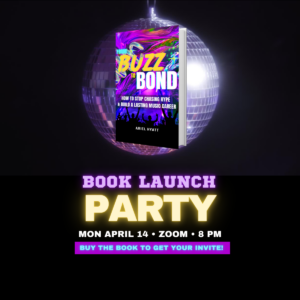Bond Marketing is a fan-building approach that prioritizes real connection over vanity metrics. Unlike the kind of music marketing that dominates today—obsessed with chasing streams, likes, and viral moments—Bond Marketing helps independent musicians create lasting, loyal relationships with fans, turning passive listeners into true supporters.
Most musicians who come to Cyber PR share a common dream:
“I want to stop relying on a day job and make music my main thing.”
It’s a beautiful and inspiring goal—but not an easy one. It requires a strategic shift in how you approach your audience, marketing, and long-term career vision.
Many have already spent thousands of dollars on playlist pitching and campaigns to increase Spotify plays, social media ads, and boosts. Some even have impressive Spotify numbers and have had a few viral moments on TikTok.
And yet—they’re stuck.
Why?
Because the most prominent mistake musicians make is assuming that awareness alone equals success.
The Trap of Buzz Marketing
Chasing Spotify plays or hoping for a viral TikTok can give you a quick hit—some vanity metrics, maybe a spike in engagement—but these moments are short-lived.
When your ad budget runs out, your momentum disappears.
Your “followers” vanish.
And the so-called “audience” you thought you were building? They weren’t truly connected to begin with.
This is Buzz Marketing—and it’s not sustainable.
Buzz Marketing costs time, energy, and money—but it rarely gives anything back. It won’t help you quit your day job or build a real career because it’s built on platforms that don’t care about your music success—only your data and your dollars.
Enter: Bond Marketing
If you’re serious about building something lasting, you need to stop playing the numbers game and start focusing on Bond Marketing.
Bond Marketing is a long-term strategy designed to help artists cultivate genuine fan relationships—the kind of relationships that lead to real support, real engagement, and real income.
The 3 Core Principles of Bond Marketing
1. Build Ownership
Get off rented land. Establish email lists, build your own website, and create direct pathways to communicate with fans outside of algorithm-controlled platforms.
2. Foster Community
Don’t just collect followers—build a space where fans feel seen, heard, and part of something. That’s where loyalty lives.
3. Provide Value
Be real. Get vulnerable. Offer things that feel like you—and create ways for fans to support that honesty.
Bond Marketing is a Mindset Shift
Marketing isn’t just about tactics—it’s about perspective.
If you approach Bond Marketing as another chore, it will feel like a grind. But if you treat it as a creative extension of your artistry—an opportunity to connect with humans who care about your work—it becomes energizing.
Your fans aren’t just likes or follows. They’re people. People who want to feel something. And when you shift your focus to consistent, meaningful connection, everything changes.
Play the Long Game
Sure, it’s gratifying to watch a track spike in streams. But one genuine fan who buys your album, joins your email list, or tells three friends about you? That’s long-term value.
Bond Marketing is about consistent, human connection—and it’s how sustainable music careers are built.
Why This Book Is Different
If you’re feeling overwhelmed, burnt out, or disillusioned by the constant pressure to “keep up” online, you’re definitely not alone. In fact, many musicians feel the same way. The reality is, most marketing advice being offered today is based on outdated tactics or platforms that constantly shift the rules—making it nearly impossible to keep up.
Instead of chasing quick wins or empty metrics, From Buzz to Bond provides a sustainable, human-centered approach that empowers you to grow your music career on your own terms.
Whether you’re just starting out or you’ve been releasing music for years, this book will help you reconnect with your purpose, reclaim your time, and—most importantly—finally start seeing real results from your efforts.
Want to Learn Exactly How to Make This Shift?
If you’re ready to move beyond vanity metrics and start building something that lasts, you’re not alone. That’s why I wrote From Buzz to Bond: How to Stop Chasing Hype & Build a Lasting Music Career.
In this book, I walk you step-by-step through the 10-stage Bond Marketing Funnel—a proven framework I’ve used with thousands of artists. It’s designed to help you shift from chasing fleeting hype to creating meaningful, long-term growth with fans who actually care.
But don’t just take my word for it. Here’s what one early reader, musician Doug Simmons, had to say:
“Just what I needed to resuscitate my passion for developing relationships with listeners of my band’s music. The Bond Marketing Funnel you present and explain in the book is my starting point for a rejuvenation into meaningful engagement with others.”
Order Now and Get an Invite to the Book Launch
The book is available now as a PDF. When you purchase it between now and April 14, 2025, you’ll receive a special invite to my Zoom book launch party on April 14th.
It’s a fast, powerful read designed to help you stop spinning your wheels and start building the fanbase you deserve.

WORK WITH US



 “Highway Prophet” by @jasminecain is more
“Highway Prophet” by @jasminecain is more







 , if
, if








